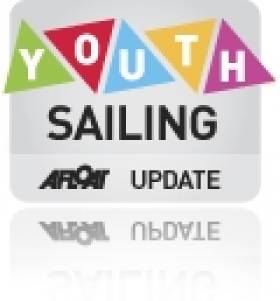Displaying items by tag: youth
ISA Youth Seminar Dates 'Postponed' Til 2017
The first of the new ISA Junior Sailing Performance Seminars was postponed last month and will now take place at a date to be announced in 2017. As Afloat.ie reported in September the ISA announced that the seminars were replacing the ISA Optimist Squads and ISA Topper Squad which have traditionally run from October to March.
The ISA said at the launch of the new initiative: 'Given our limited resources we feel this approach will give a better return on investment while at the same time giving the pathway much more visibility across a wider base'.
Scheduled for the Irish Institute of Sport last weekend the first of three winter seminars was aimed at 'junior sailors of all classes born between 2001 and 2004 who are passionate about their sailing and want to learn important skills which will help with their overall development in the sport'.
No reason has been given as to why the October date was postponed by the ISA on its website here.
The seminars aim to educate sailors about the ISA pathway and help sailors understand their options and choices when graduating through the different sailing classes.
The opening seminar will focus on education of the sailor in areas outside the technical skills of sailing their chosen class. Topics covered at the seminar will include –
The cost of the first weekend seminar is €50 per sailor.
The KBC Laser Radial Worlds (Youth and Men’s 2016 World Championships) was launched at a special event in Dún Laoghaire Harbour Company’s historic Harbour Lodge today. This is the first time Ireland will host this sailing World Championship which, according to Eithne Scott-Lennon, Chairperson, Dún Laoghaire Harbour Company “will showcase Dún Laoghaire Harbour on the international sailing stage”. Up to 400 competitors from more than 35 nations will compete in this World Championship Series which will generate €2.5m for the local economy.
KBC Bank Ireland is the title sponsor of this prestigious sailing event which takes place in Dún Laoghaire harbour from 23rd to 30th July and will be hosted by The Royal St. George Yacht Club and Dún Laoghaire Harbour Company. The event is supported by Dun Laoghaire Rathdown County Council and Fáilte Ireland.
Eithne Scott-Lennon, Chairperson, Dun Laoghaire Harbour Company said, “This summer Dún Laoghaire Harbour will be the first Irish host of the eagerly awaited KBC Laser Radial Youth & Men’s World Championships. The Harbour Company along with the Dún Laoghaire Yacht Clubs formed a small group in 2013 to promote the harbour as a location for International Sailing Events. We are delighted that the 2016 ‘KBC Laser Radial Worlds’ is a direct result of that initiative.”
Patt Watt, Director of Retail Distribution, KBC Bank Ireland said, “As Ireland’s newest retail bank we are delighted to sponsor this world-class sailing event. Our sponsorship acknowledges our commitment to supporting community and youth initiatives and recognises the hard work and dedication that is involved by everyone concerned in hosting this event. We wish everyone every success and look forward to being part of a great sporting occasion next July.”
David Kelly, Chairman of the KBC Laser Radial Worlds said, “This is a significant achievement and an exciting milestone in the sailing history of Dún Laoghaire. Apart from the financial benefits locally, it is a unique opportunity to showcase our beautiful harbour and everything Dún Laoghaire has to offer. We are looking forward to some top-class sailing and to welcoming all our competitors from all over the world.”
1,000 supporters and volunteers will be involved in helping to host the KBC Laser Radial Worlds. Over the past number of years Dún Laoghaire has played host to some of the most prestigious European & World Sailing Championships including the Youth Sailing World Championships in 2012.
ISA Youth Sailing Titles Decided in Howth
Howth Yacht Club hosted the ISA Youth Sailing Pathway National Championship and Optimist Trials over the four days from 31st March to 3rd April in varied conditions reports Emmet Dalton of HYC. The regatta attracted 192 entries across five classes from all corners of Ireland (plus a visitor from Italy) and produced Champions from seven clubs. Full results downloadable below.
Thursday's racing was delayed while the wind found time to behave and steady itself. The fleet wasn't too unhappy to wait in the glorious Spring sunshine before getting proceedings off. In the 420 Class, local favourites Elmes/O'Sullivan had it their own way with two bullets. The Laser Radial top spot was shared by O'Beirne (RStGYC), Durcan (RCYC) and Nicole Hemeryck (NYC). Over on the Topper course, the RStGYC was again dominating, with Jack Fahy burning up the course. Rush's Ross Morgan was definitely in a hurry on the Laser 4.7 course, leading by 6 points after Day 1. By the end of the day, the wind had picked up and a lot of tired faces reached the top of slipways, concentrating on the next race...to their dinners!
Day 2 fell victim to the element, with strong and increasing winds keeping the fleet ashore. Principal Race Officer, Derek Bothwell, was cheered by the competitors as he announced a day off. Cinemas and shopping replaced the usual windward mark targets.
With a window of opportunity in the weather, the fleets headed afloat on Saturday, hoping to catch up on the schedule with a few additional races. On the 420/Laser Radial course, four races were crammed, suiting Malahide 420 duo Gemma and Cara McDowell. The sisters closed the gap to the leaders and ended the day only a point adrift of Elmes/O'Sullivan. Radial and 4.7 gurus O'Beirne and Higgins never fell onside the top three for the day. On the Topper course, Carroll was fighting off a strong challenge from another Hemeryck, this time Ella who was only a couple of points behind. Almost a carbon copy of Day 1, Saturday saw some tired bones come ashore!
As the sailors were chasing around the race course, members and visitors did loops of the Peninsula in some spectacular cars, presented by Aston Martin and Bentley. HYC friends in Charles Hurst Motors spent a day showing off Vantages, Continentals, Rapides and, ideal for the Circuit Sailors, the new Bentley Bentayga. Rarely has the clubhouse been so full of grinning faces on a rainy day!
Going into the final day, titles could have been won or lost, testament to the incredibly close racing across a range of conditions. At the end of the day, the Champions filtered to the top and were presented with their medals by ISA President David Lovegrove and cheered by their fellow competitors.
Champions
420
Dougie Elmes / Colin O'Sullivan (Howth YC)
Girls: Champions Gemma and Cara McDowell (Malahide YC)
Laser Radial
Conor O'Beirne (Royal St. George YC)
Girls: Nicole Hemeryck (National YC)
Topper
Michael Carroll (Kinsale YC)
Girls: Ella Hemeryck (National YC)
Laser 4.7
Henry Higgins (Royal St. George YC)
Girls: Heather Spain (National YC)
Youth Worlds Update: Elmes & O'Sullivan Move Into Third, Australian Boys Disqualified From Race 8
Irish 420 pairing Douglas Elmes and Colin O'Sullivan have moved into third place at the World Youth Sailing Championships and are within a single point of the silver medal after Australians were sensationally disqualified from race eight this afternoon in Malaysia.
As a result the Howth Yacht Club duo have it all to play for in tomorrow's final race where Ireland could yet win silver or bronze but equally could lose out in a cliff–hanger race nine as the Australian boys, Alec Brodie and Xavier Winston Smith, are only four points adrift in fourth place.
Race Coach / Bosun Vacancy in Hong Kong
#jobsinboats – The Royal Hong Kong Yacht Club, one of the oldest sailing and rowing clubs in Hong Kong, is looking for a talented and youthful dinghy sailor to fill the post of Race Coach / Bosun.
This is a full-time contract based in Hong Kong commencing July or August 2015. Reporting to the Middle Island Sailing and Marine Manager, the successful applicant will coach up and coming cadets to higher levels of racing expertise. Classes of boats include the J80, Optimist, Laser, 420 and 29er. Coaching and mentoring at international events will be involved. Off-water there will be basic fibreglass repairs and maintenance of sailing craft and RIB's to be completed. Middle Island has a clubhouse, sailing academy, hardstand, marina and launching areas serviced by a regular club ferry.
We are looking for people with:
- Extensive dinghy racing experience.
- Graduation from an internationally recognised sail training academy.
- Race Coach qualification is essential with Keel Boat Instructor preferred.
- Excellent interpersonal, team and leadership skills.
- Fibreglass repair experience and confidence to install small boat rigs and deck equipment to a professional standard.
- Flexibility to work weekends and midweek shifts.
We offer attractive remuneration and excellent fringe benefits to the right candidate. Closing date for applications is 15 June 2015. Interested parties should submit a comprehensive CV together with a recent photograph to The Human Resources Manager, Royal Hong Kong Yacht Club, Kellett Island, Causeway Bay, Hong Kong or e-mail to [email protected]
Youth Sailing Champions Are Saluted at Royal Cork Yacht Club
#youthsailing – Sunday turned out to be a miserable morning with winds gusting 30 knots at Roches Point and resulted in Principal Race Officer Peter Crowley cancelling all racing for the four youth sailing Classes writes Claire Bateman. Consequently, prize giving for these fleets was moved forward to 1.30 pm and facilitated an early journey home for the competitors.
In the Topper Class Geoff Power of Waterford Harbour Sailing Club took first place with a four point lead, while Luke McElwaine of Newcastle Yacht Club/Carlingford Lough Yacht Club came in second, only one point ahead of Tom Keal of Royal Cork Yacht Club in third place. First female Topper sailor was Caoimhe Foster of the host club, who came in fourth overall, only one point behind third place. The Toppers only managed four races over all in the event due to adverse weather. These results will be part of the basis for choice to compete for the Topper Summer Squad and the final decision on the full squad will be made in the coming weeks.
In the Laser 4.7 class the winning sailor was Henry Higgins of Royal St George Yacht Club and overall second placed sailor and winning female sailor was Rebecca O'Shaughnessey of Royal Cork Yacht Club with third place going to Conor Quinn of Carlingford Lough Yacht Club. This is an indicator event for the 4.7 ISA squad for the summer, along with other event results.
The performance of the Laser Radial girls at this event has to be noted, with five girls in the top ten and Erica Ruigrok of Rush Sailing Club coming in at third place, also giving her the first female result. Conor O'Beirne gave the most consistent performance over the nine races and gained first place. Second place went to Cian Byrne of Royal Cork Yacht Club who showed good local knowledge of winds and tides and used them to his advantage.
There was an extremely tight battle for first place in the 420s between Douglas Elmes and Colin O'Sullivan, of Royal Cork Yacht Club and Howth Yacht Club, and Peter McCann and Harry Whitaker, also Royal Cork, who took the overall prize. James McCann also Royal Cork, with Bill Staunton of Skerries Yacht Club as crew, was hot on the tail of his elder brother throughout the event and finished in third place. Lizzy McDowell and Anna O'Regan of Malahide Yacht Club were not far behind and took fourth place and first female position.
Meanwhile the wind had abated and shifted to the North and enabled racing to commence for the hardy optimists and this was particularly important in that places were up for grabs for the Worlds Team, the European Team and a Development Squad. Two races were sailed giving them a total of thirteen races over the event.
Top scoring Optimist in the Trials was Micháel Ó Suilleabháin KYC followed by Harry Bell of HYC second, followed by Gemma McDowell of MYC in third place.

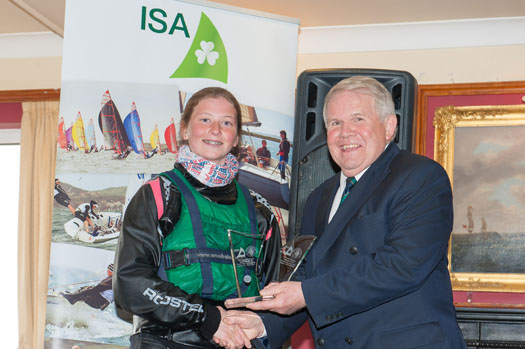
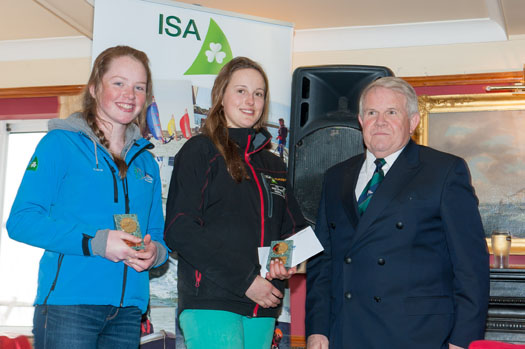
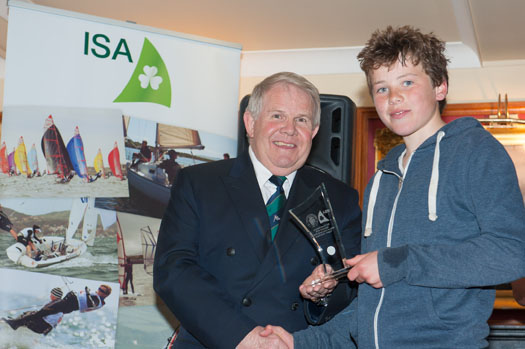
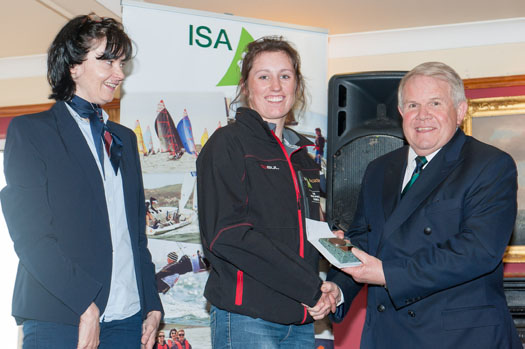
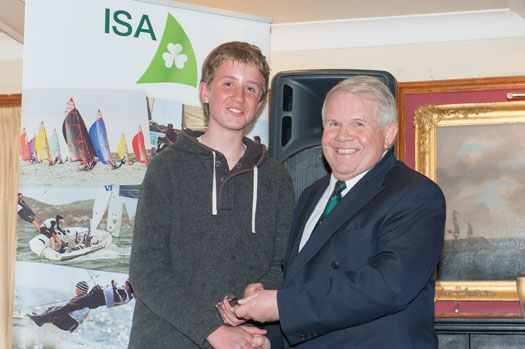

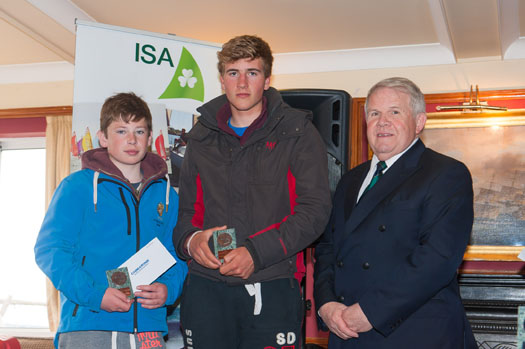
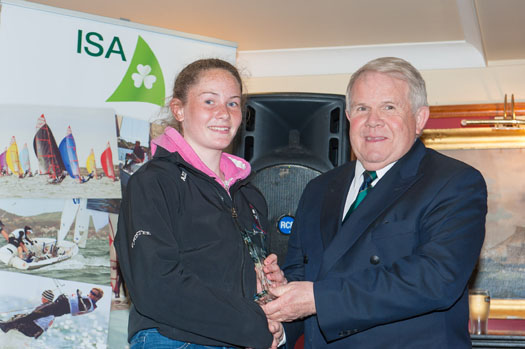
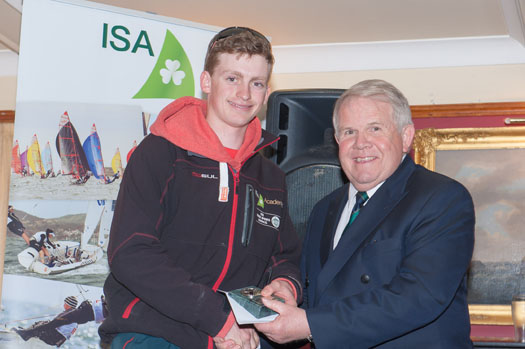

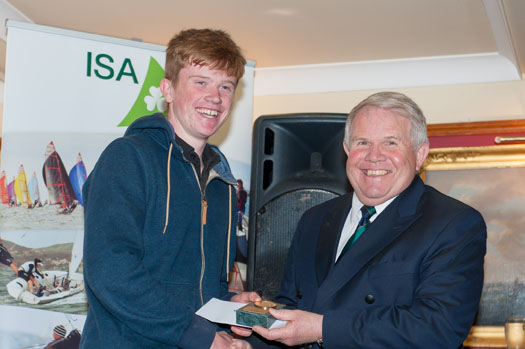
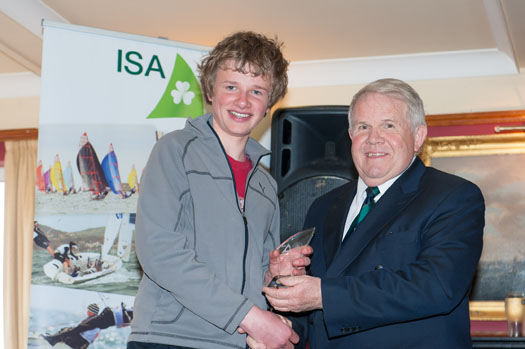
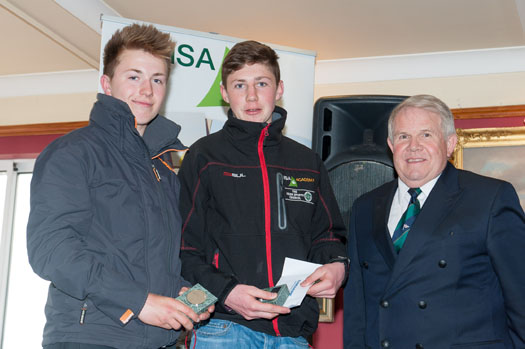
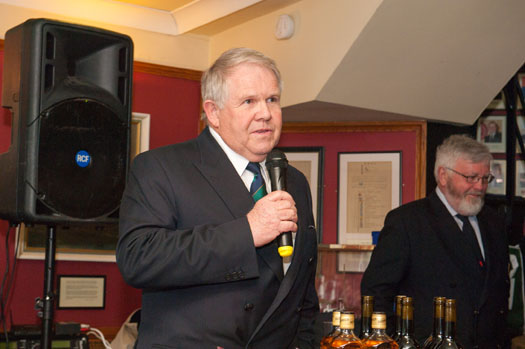
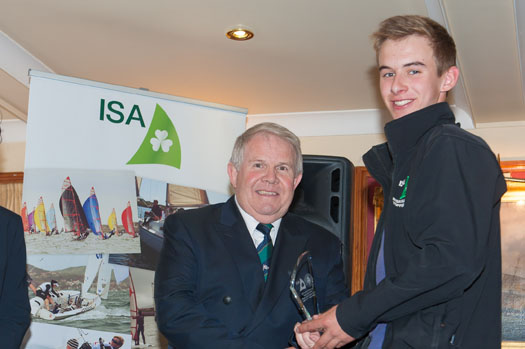

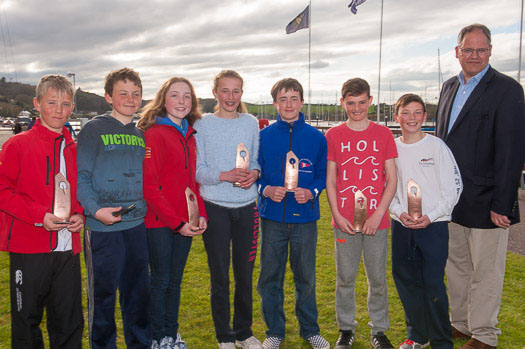

#youthsailing – The Youth Sailing Nationals for Topper, 420, Laser 4.7 and Laser Radial will be hosted by Royal Cork Yacht Club from tomorrow, Thursday 9th to Sunday 12th April 2015. This is an open event for all sailors in these classes writes Claire Bateman.
Today at the RCYC the air was filled with excited chatter and greeting of friends arriving from all over Ireland. Conditions were ideal with bright sunshine and sailors quickly got down to the last minute preparations and checking of their gear. The Optimists were weighed and they had their sails stamped.
The ISA Youth Pathway Nationals will be the selection trials (or part of) for National squads and an indicator (amongst other events) for the Academy. Classes sailing will be 420, Laser Radial, Laser 4.7 and Topper. The IODAI 2015 Optimist Trials will be held in conjunction with, but sailed on a separate course from the Championships. There will not be an Optimist fleet in the ISA Youth National Championships 2015. Tomorrow Thursday the Laser Radials and 420s will commence racing. Tomorrow will also see the beginning of the Optimist four day IODAI Trials with Anthony O'Leary Afloat Sailor of the Year as Race Officer, and Friday will see the commencement of racing for the Topper and Laser 4.7 fleets.
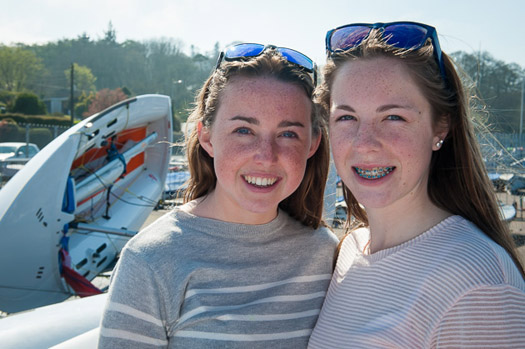

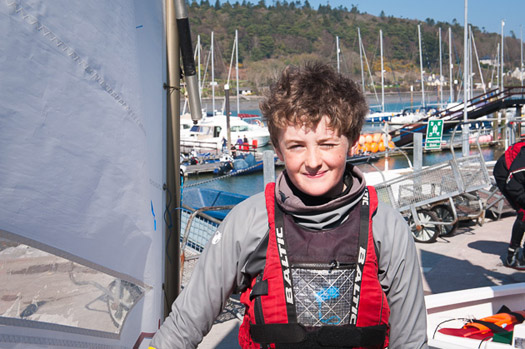

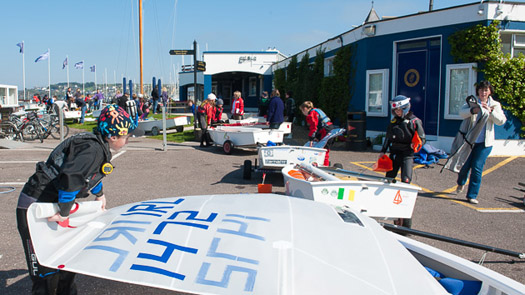
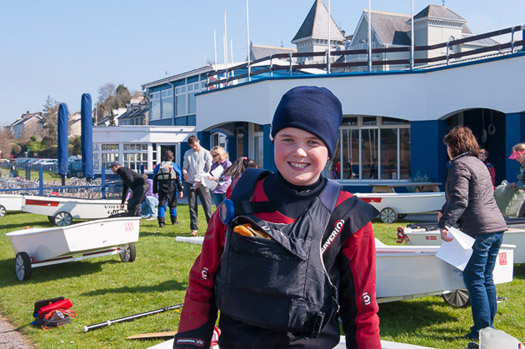
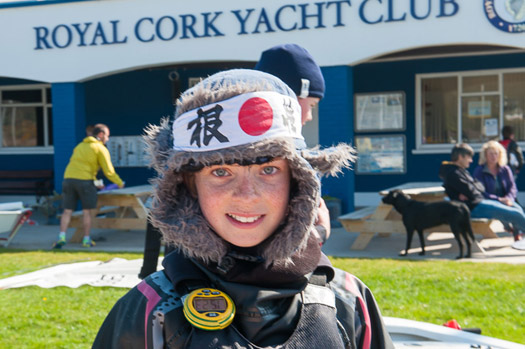
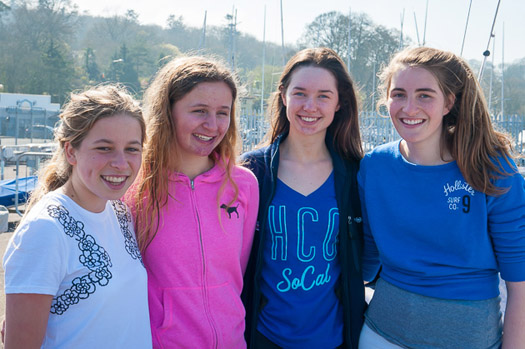
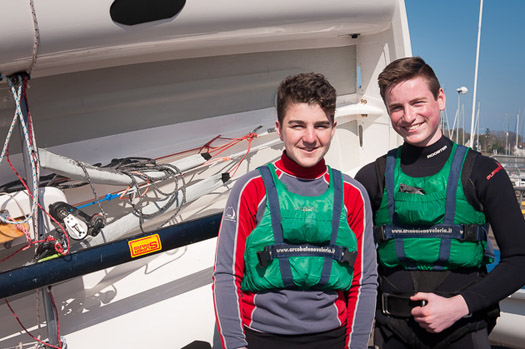
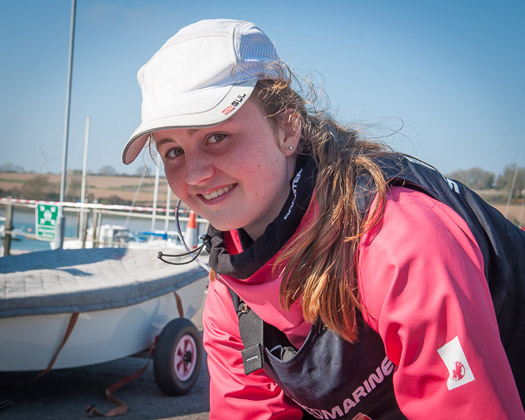
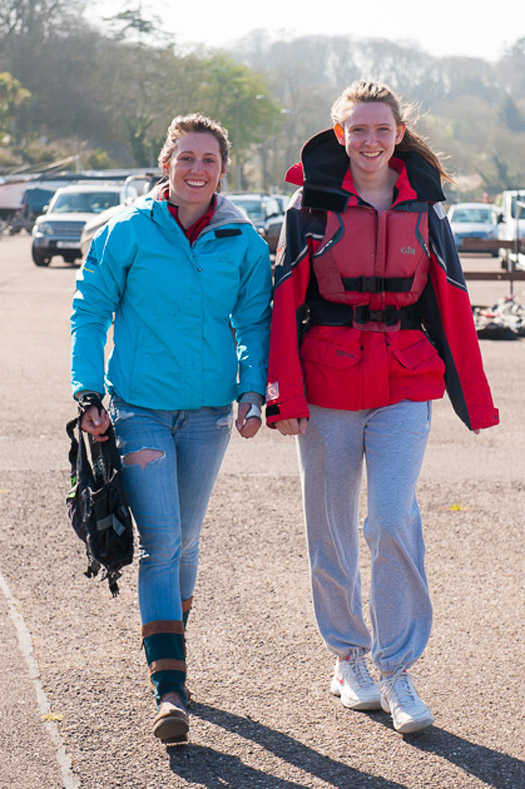
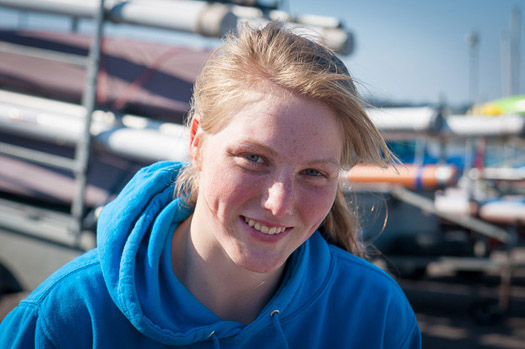

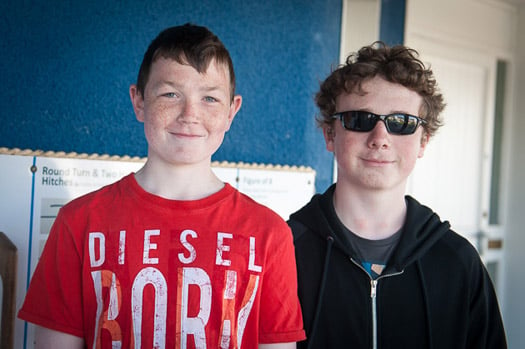
Tall Ships & Sail Training – Ireland's Atlantic Youth Trust Will Give It A Different Spin
#tallships – Rugged sailing in romantic tall ships; the camaraderie of the sea; character development. It's an inspiring combination which has gripped maritime nations for more than a century as sail has given way to more utilitarian sources of power. First there was steam. Then steam in turn was superseded by diesel and even nuclear power. And with each stage, there has been a remorseless drive towards reducing manning levels.
So what on earth is there now to occupy people who, in a former era, might have found a meaningful role in life as crew on board a sailing ship? For with each new development in shipping, we realise ever more clearly that large sailing ships were one of the most labour-intensive objects ever created.
However, we don't need to look to the sea to find areas of human activity where technological development has made human input redundant, and large sectors of the population largely purposeless. It's the general social malaise of our time. So for many years, the majority of maritime countries have found some sort of solution by an artificial return to the labour-intensive demands of sailing ships.
But in an increasingly complex world with ever more sources of distraction and entertainment, does the established model of sail training still work as well as it once did? W M Nixon meets a man who thinks we need a new vision for best using the sea and sailing ships to meet the needs of modern society's complex demands.
Tall Ships and Sail Training........They're evocative terms for most of us. Yet the buzzwords of one generation can surprisingly quickly become the uncool cliches of the next. That said, "Tall Ships" has stood the test of time. It's arguably sacred, with a special inviolable place in the maritime psyche.
So when we see a plump little motor-sailer bustling past with some scraps of cloth set to present an image of harnessing the wind's timeless power, we may be moved to an ironic quoting of Robert Bridges: "Whither, O splendid ship......" But somehow, citing Masefield's "a tall ship and a star to steer her by" would seem to be beyond the bounds of even the worst possible taste.
There's a simple purity about "Tall Ships". It works at every level. Google it, and you'll find the academics claim that it became official with its use by John Masefield in 1902 and Joseph Conrad in 1903, though Henry David Thoreau used it much earlier in 1849. But Conrad being the benchmark of most things maritime in academia, 1903 seems to be set in stone.

We all know what is meant by a true Tall Ship, but as these rig profiles indicate, the proliferation of sail training programmes has led to an all-inclusive approach
Yet at the vernacular level, it has been there much longer than any of them. There's a bit of maritime meteorological lore which our academics would probably dismiss as vulgar doggerel, but I've found it still moves me. When far at sea, with the underlying swell increasingly in evidence and the weather conditions which it describes clearly developing overhead, inevitably you'd remember this little couplet:
"Mackerel sky and mare's tails,
Make Tall Ships carry low sails".
It's not Yeats. But when you're on a formerly blue sea now turning grey and far from anywhere in a 25-footer, it's a little thought which can still make the hairs stand up on the back of your neck. And it's that mention of "Tall Ships" which gives it the added resonance. So things stand well with the phrase "Tall Ships". But what's the word on the continuing viability of "Sail Training"?
"I'm fed up with the constant use of the term "Sail Training". It's bandied about so much it has become meaningless. And always talking about "Sail Training" limits the scope of what we're trying to do. If we could find some useful phrase to replace "Sail Training", but something which is also more visionary than the very pedestrian "Youth Development" which is sometimes replacing it, then maybe we could go a long way to capture the imagination both of our potential supporters, and of the young people we hope will want to come aboard the ship".
The speaker is Neil O'Hagan, busy Executive Director of the Atlantic Youth Trust, which is actively developing ways and means of building a 40 metre sailing ship which will serve all Ireland in a wide variety of functions. And as he has immersed himself in this challenging project when he is clearly a very able person who could name his price in many roles in high-paying large corporations, it behoves us to pay attention.
We have been skirting the AYT and its project several times here recently. But as we gradually emerge from the recession and see what is still standing, for some reason with every passing week we find it ever more disturbing that the Irish Sail Training Brigantine 84ft Asgard II was lost nearly seven years ago by foundering, and the Northern Ireland Ocean Youth Trust's 60ft ketch Lord Rank was lost after striking a rock five years ago.
Far from being swept under the carpet, it's a double whammy which has to be faced and dealt with as 2015 rolls on with the biggest Tall Ships assembly ever seen in Ireland coming to Belfast, and not an Irish Tall Ship worthy of the name to represent us.

The popular image of Tall Ships is a crowded port with a fun-filled crowd...............
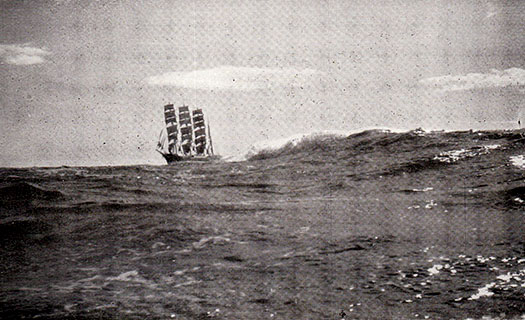
.....yet for many old salts, the true image is the lone ship at sea, going about her business. This photo of a four-masted barque was taken from a small cruising boat in the 1930s
But an ideas-laden shooting of the breeze with O'Hagan soon shows that we're going to have to learn to think a long way out of the box before we begin to meet the demanding expectations of this man and his board of trustees and directors, and the much-anticipated presence of the Tall Ships in Belfast is only a trigger to help activate a much more complex vision. Neil O'Hagan hopes not only to be instrumental in the creation of a new Irish sailing ship, but he also hopes to change the way in which we perceive such a vessel, and our expectations of the way she will be used.
In our initial blog on this back on January 17th, we thought we were making a tellingly adverse point in suggesting that the barquentine Spirit of New Zealand - which the AYT reckons will provide the best model for the development of their project – is not so much a sail training tall ship as we know it, but rather, with her large complement of 40 "trainees", she's more of a floating schoolship which happens to set sails.
Far from being blown out of the water by this "damning" criticism which I and others had voiced, O'Hagan was delighted that we'd lit upon this aspect of the plan. "Old-fashioned sail training has had its day" he says. "When education authorities and social service bodies and welfare funds and philanthropic organisations are looking for some way to provide interesting, satisfying and ultimately long-term-beneficial experiences for young people of all backgrounds and varying states of mental health including the very happily normal, they expect a much broader curriculum than is provided by the traditional sail training model".
"And come to that, so do the young people themselves. If sailing is genuinely their great leisure interest, they'll be into it already at a personal level among like-minded friends. But if they're more typical young people of today, they'll have a wide range of interests, and during the ten day cruises which we hope to make the backbone of the new ship's programme, the sailing will only be part of it."
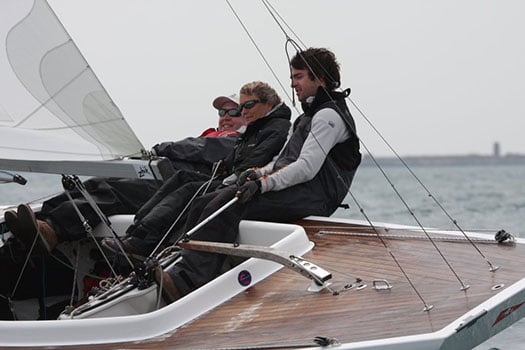
Away from the day job - Neil O'Hagan helming a Dragon
Its not that O'Hagan is anti-sailing. Far from it – he has been seen in the thick of things in the midst of the International Dragon Class in recent years. But a good liberal education with time in the Smurfit Business School in UCD and extensive family links all along Ireland's eastern seaboard north and south, plus direct business experience in both Dublin and Belfast, give him a breadth of vision to provide the AYT with a real sense of purpose.
The Atlantic Youth Trust has been quietly building itself since it emerged from a representative workshop researching the building of a sailing ship for Ireland, held in Dublin Port in the Spring of 2011. From that, a Steering Group of Lord Glentoran and Dr Gerald O'Hare from the north, and Enda O'Coineen and David Beattie from the south – all of whom had worked together before on other north-south youth sailing projects – was set up, and they commissioned a professional consultancy group – CHL Consulting of Dun Laoghaire – to work with them in producing a Vision & Business Plan, which eventually ran to 96 detailed pages.
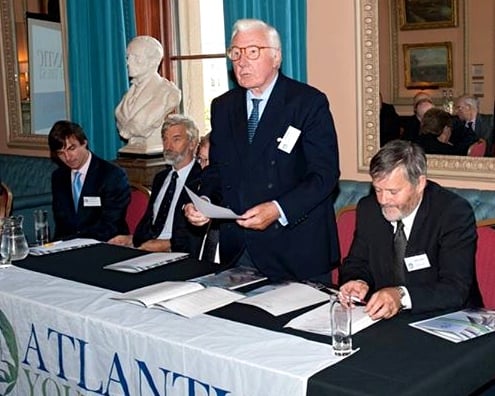
The Chairman Lord Glentoran (Gold Medallist at the 1965 Winter Olympics) at the AGM of the Atlantic Youth Trust with Executive Director Neil O'Hagan (left), Sean Lemass and Director Enda O'Coineen (right)
In due course, the Atlantic Youth Trust emerged with Olympic Gold Medal veteran Lord Glentoran as Chairman. And with Neil O'Hagan as Executive Director, the show was on the road with the detailed worldwide investigation of 25 successful educational schemes involving sailing ships - note we've dropped that "sail training" tag already. And in New Zealand they found something that was really new, something that fell in with their view that the double loss of the Asgard II and the Lord Rank provided an opportunity for a truly fresh look what a national sailing ship might be and do.
It's an extraordinary place, New Zealand - particularly from a maritime point of view. Far from seeing their isolation as a drawback, they use it as an advantage for fresh thinking. And they don't cling to time-hallowed ways brought over from "the old country". On the contrary, being in a new country is seen almost as an imperative for trying new ways and ideas, hence they're at the sharp end of top events like the America's Cup.
And as they were far from the fleets of established tall ships in Europe and America, with the Spirit of New Zealand they had to develop new ways of using a vessel which would spend much of her time cruising their own extensive and very varied coastline on her own, distant from the Tall Ship sailfests which are such a feature of the programme in the more compact and crowded parts of the world.

Spirit of New Zealand is barquentine-rigged
Thus by geographic necessity. New Zealand is ahead of the curve in developing ways of contemporary validity in the use of large sailing ships. We all hear of what a marvellous party the Tall Ships will activate in Belfast, just as they've done before in Dublin, Cork and Waterford. But hold hard just a moment. Isn't sail training aimed at young people mostly between the ages of 15 and 25? Surely their central involvement in vast open air quayside parties - with the inevitable underage alcohol intake possibilities – is totally at variance with the healthy idealism of the concept?
For sure, the organisers of modern Tall Ships Festivals go to enormous effort to ensure that they're genuinely family-friendly events. But the ancient traditions of sailors in port can be difficult to escape. So when you've a proposed programme which is essentially based on recruitment through continuing contact with secondary schools and similar age cohorts – as is the case with the Atlantic Youth Trust project – then it becomes increasingly desirable to have a ship which is large enough to be self-sufficient, with a viable way of onboard life built around large shared areas, such that the traditional waterfront-oriented harbour visits will no longer be such an important part of the cruise programme.

Splendid isolation. Spirit of New Zealand in an anchorage remote even by New Zealand standards
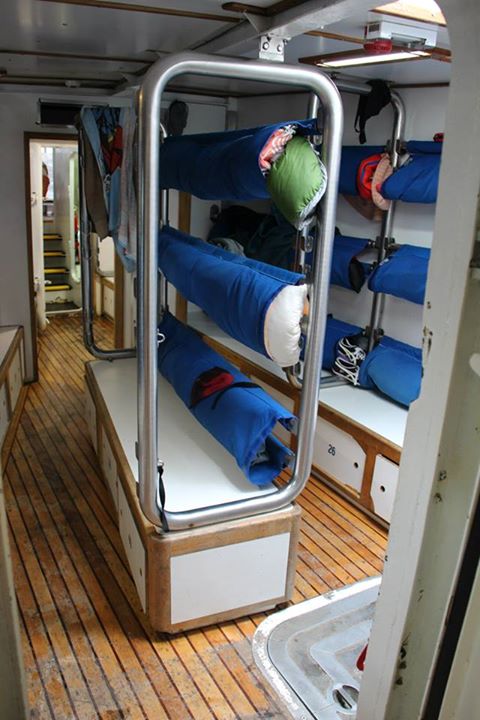
Packing them in....as she carries a crew of 40 trainees, and with space required for extensive communal areas, Spirit of New Zealand's bunks are efficiently planned
Of course the new vessel will take part in Tall Ships Races and Tall Ships Festivals, and of course she'll make the occasional ambassadorial visit, both along the Irish coast and abroad. But with the underlying philosophy of the ship being largely self-sufficient of shoreside distractions other than when they're environmentalist and educational ventures, sometimes with an expeditionary element, then the more gregarious aspects of her yearly routine will be kept well in perspective, and everyone will be the better for it.
As it's essentially a cross-border venture, equal funding from the two governments – each of which it is hoped will put up 30% of the capital expenditure - is anticipated, and with a fresh tranche of Peace Process money on the horizon, the resources are gradually building as people get used to the idea. There has also been much technical background research, and leading naval architects Dykstra of The Netherlands are on the case with an impressive scenario, for as Trustee and Director David Beattie has put it, this one isn't going to be cobbled together, it's going to be a "best in class project".
As the planned use of the vessel is essentially civilian, she will be Ireland's sailing ship without being the national sailing ship. There's more than a slight difference to the Asgard situation. In many other countries, the most impressive tall ships are part of the naval service, but in Ireland we have a Naval Service sailing vessel already, she is the ketch Creidne which was the national sail training vessel between the decommissioning of the first Asgard in 1974 and the commissioning of Asgard II in 1981. In recent years, she has had a major refit and is now actively sailed, but as Ireland's Naval Service is so essentially Cork-based, the Creidne is very much part of the scene in Cork Harbour and the Naval Base at Haulbowline.
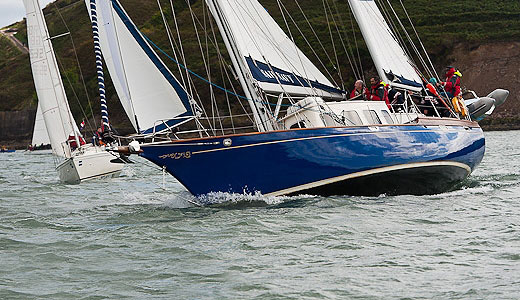
The Naval Service have Creidne for sail training purposes for their own personnel. Photo: Bob Bateman
In fact, although the Atlantic Youth Trust does have a Cork element to it, and advisers include several leading figures in the Cork marine industry, the reality is that it is first and foremost a cross-border enterprise between offices in Dublin and Belfast.
This means that Cork – which is the true capital of maritime development in Ireland, and I mean that in all seriousness – is an associate port to the Atlantic Youth Trust project, rather than a central pillar of it. But I don't think the people of Cork would wish to have it any other way. When I was in the southern capital for the fund-raiser for the new National 18 class development a month or so ago, Class President Dom Long kicked off proceedings by explaining how it was the Corkonian sense of independence which had inspired the mighty leap in National 18 design. He did this by showing a map which neatly illustrated the Cork sailor's view of Ireland.

The Cork sailor's view of Ireland
It says everything. But I don't think the Atlantic Youth Trust should lose any sleep over the fact that they might be seen as being on a Dublin-Belfast axis from which Cork is as usual going its own sweet way. 'Twas ever thus. And anyway, in the end the Corkmen will probably provide many of the officers for the proposed new vessel to which we wish, on this fine Easter Saturday morning, the very fairest of fair winds.
2015 ISAF Youth Match Racing World Championship Notice Of Issued
#matchrace – The Notice of Race for the 2015 ISAF Youth Sailing Match Racing World Championship set to be held in Swinoujscie, Poland from 15 – 19 September 2015 has been released.
Organised by the Polish Match Tour in conjunction with the Polish Yachting Association and the International Sailing Federation (ISAF), this ISAF Grade W event will welcome 12 skippers racing in TOM28 boats.
In its second year following the successful 2014 inaugural edition (won by Joachim Aschenbrenner (DEN) the 2015 ISAF Youth Match Racing World Championship is open to competitors under 23 years old on 31 December 2015.
ISAF Member National Authorities may apply for an invitation for a skipper of their nationality by sending a completed entry form to ISAF no later than 30 April 2015. ISAF will inform MNAs and skippers if they will be issued with an invitation no later than 15 May 2015.
Durcan Leads as Royal Cork Sailors Dominate Junior All Ireland Sailing Contest in Kinsale
#allireland – Wild card entry Harry Durcan leads the Junior Helmsmans championhips at Kinsale Yacht Club this evening by a singe point from his Royal Cork clubmate Peter McCann. Durcan's twin brother Johnny is lying third after four races sailed in a dominant display by Royal Cork youth sailors. Full results below.
16 young helms waited breeze until 1pm today before the first race of the ISA event commenced in a ten–knot southerly, just enough to get them moving. As they came down on a run to the finish line the winds abandoned Kinsale Harbour all together and boats were left drifting. A maximum race time was set for 40 minutes and race was abandoned before any boats made it to the finish line. Boat number 3 with James McCann and Michael Carroll from Royal Cork Yacht Club were only 10 metres from the finish line.
Race two commenced in 8 knots of breeze with a cloud formation that seemed to promise consistent winds and the promise came through. Cliona NiShuillebhain and Jill McGinley of Kinsale Yacht Club gave a steady performance throughout the race and remained in the lead spot to the finish line.
The wind stayed with them and at 15:00 race three commenced. Séafra Guilfoyle and Michael Carrol of Royal Cork Yacht Club worked their way up through the fleet to cross the finish line first.
Race four started at 16:00 – the two Harry's (Durcan and Whittaker) from Royal Cork Yacht Club started with a good lead and were first round the weather mark on the first beat and again first round on the second beat with a 40 second lead. The tide started flooding up to 3knots, which caught a few competitors that took the course wide were held back, with 8 competitors resulting in DNF from not going over the finish line within the time limit.
Winds became light again for race 5 and five resulted in DNF. The girls from Kinsale Yacht Club slammed it again and won Race 5, with Peter McCann and Michael O'Suileabhan in 2nd place and the Harries in at 3rd.
Results after day one
|
Series Place |
Sail No |
Class |
Helm |
Crew |
Club |
Series Points |
||||
|
1 |
12 |
Wild Card |
Harry Durcan |
Harry Whittaker |
RCYC |
10 |
3 |
3 |
1 |
3 |
|
2 |
4 |
International 420 |
Peter McCann |
Michael O'Suileabhain |
RCYC |
11 |
5 |
2 |
2 |
2 |
|
3 |
13 |
Laser 4.7 |
Johnny Durcan |
Florence Lyden |
RCYC |
17 |
2 |
5 |
3 |
7 |
|
4 |
16 |
International 420 |
Cliodhna NiShuillebhain |
Jill McGinley |
KYC |
20 |
1 |
12 |
6 |
1 |
|
5 |
15 |
Youth Worlds |
Seafra Guilfoyle |
Conor Horgan |
RCYC |
22 |
6 |
1 |
11 |
4 |
|
6 |
10 |
Optimist |
Gemma Mc Dowell |
Cara McDowell |
Malahide YC |
26 |
4 |
7 |
10 |
5 |
|
7 |
18 |
Mirror |
Shane McLoughlin |
Oscar Langan |
Sutton DC |
38 |
9 |
10 |
8 |
11 |
|
8 |
20 |
Optimist |
Clare Gorman |
Amy Carroll |
National YC |
39 |
8 |
4 |
21 |
6 |
|
9 |
19 |
Laser 4.7 |
Rory Caslin |
Scott Levie |
National YC |
42 |
21 |
9 |
4 |
8 |
|
10 |
3 |
Optimist |
James McCann |
Michael Carroll |
RCYC |
44 |
21 |
6 |
5 |
12 |
|
11 |
5 |
Topaz |
Paddy Cunnane |
Adam Byrne |
Dingle SC |
45 |
7 |
8 |
9 |
21 |
|
12 |
17 |
RS Feva |
Triona Hinkson |
Catherine Kelly |
Royal St. George YC |
49 |
15 |
13 |
12 |
9 |
|
13 |
6 |
Topper |
Adam D'Arcy |
James Hassett |
RCYC |
51 |
18 |
16 |
7 |
10 |
|
14 |
7 |
RS 200- Youth |
Stephen Craig |
Morgan Lyttle |
Royal St. George YC |
58 |
13 |
11 |
21 |
13 |
|
15 |
9 |
GP14 - Youths |
David Johnston |
Meisha Johnston |
Sutton DC |
69 |
12 |
15 |
21 |
21 |
|
16 |
8 |
RS Feva |
Alison Dolan |
Grainne Young |
Blessington SC |
70 |
11 |
17 |
21 |
21 |
|
17 |
11 |
Topper |
Ros Morgan |
Ronan Walsh |
Skerries SC |
70 |
14 |
14 |
21 |
21 |
|
18 |
1 |
Topper |
Hugh Perette |
Conor Kneafsey |
National YC |
70 |
17 |
18 |
21 |
14 |
|
19 |
14 |
Mirror |
Tiarnan Dickson |
Rory MacAllister |
Lough Ree YC |
71 |
10 |
19 |
21 |
21 |
|
20 |
2 |
Topaz |
Jack Kiely |
Joey Curran |
Dungarvan HSC |
79 |
16 |
21 |
21 |
21 |
































